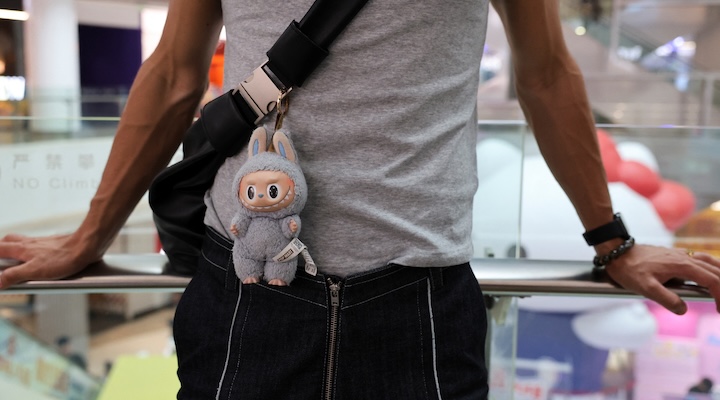For the past two years, the toothy, furry elf Labubu, designed by Hong Kong artist Kasing Lung, has dominated the global collectible toy market. The blind-box series sparked queues outside Pop Mart stores, frenzied resale markups and even a US$170,000 auction record for a life-size doll. Yet signs are emerging that the craze may be plateauing. On September 15, Pop Mart International Group’s shares slid nearly 9 per cent in early Hong Kong trading, their steepest intraday drop since April, befo
efore closing down 6.4 per cent, after JPMorgan Chase downgraded the firm, citing concerns about weak growth catalysts and overvaluation. The rout wiped billions from the company’s market value, with founder Wang Ning’s fortune shrinking by nearly $6 billion in less than a month.
Meanwhile, on Dewu, China’s leading resale platform, prices for a cotton-candy-pink Labubu keychain have tumbled 30 per cent in two months, now at RMB160 ($22). A yoga-themed figurine set has seen resale prices slide 37 per cent since its March debut.
Pop Mart has blamed oversupply, noting that wider availability is ultimately healthier for the brand’s long-term growth. But for a company that has built its business on scarcity and hype, declining resale premiums may signal a potential cooling of demand.
The making of a monster
Born in 2015 from Lung’s The Monsters storybook series, the rabbit-eared sprite was designed as a kind but bumbling figure inspired by Nordic mythology. When Pop Mart partnered with Lung and Hong Kong collective How2work in 2019, Labubu vaulted from niche art figurine to mass-market icon.
The turning point came when global superstar Lisa Manobal of Blackpink shared images of her Labubu Macarons collection on Instagram. The endorsement introduced Labubu to millions of fans worldwide, dramatically boosting Pop Mart’s visibility.
The blind-box format only added fuel. Each sealed package offered a chance at surprise, common characters for casual fans, rare “secret” figurines for diehards chasing completion. Secondary market prices often surged tenfold, feeding a frenzy that helped push Pop Mart’s 2023 revenues past RMB5 billion, with Labubu accounting for a disproportionate share.
Soon, Labubu was everywhere. Celebrities including Marc Jacobs, Lady Gaga, Rihanna and Dua Lipa were spotted with figurines or themed accessories. Counterfeit versions, nicknamed Lafufu, flooded markets – a perverse sign of success. And in a bid to reposition Labubu as more than a fad, luxury leather goods house Moynat launched a collaboration with Lung this year, producing limited-edition bags and accessories featuring the mischievous monster.
Yet this omnipresence may be the brand’s Achilles’ heel.
Virality’s expiration date
According to Kayla Marci, a fashion and retail analyst who writes the “Haute Garbage” blog on Substack, while the success of Labubu has catapulted PopMart into an industry-spanning juggernaut, its leading character now faces the risk of saturation.
“Brands continue to chase the next ‘it’ license, relying heavily on nostalgia and joy to create cultural moments,” Marci told Inside Retail. “But as we saw with Barbie – and now Labubu – our rapid-consumption culture causes trends to burn out faster than ever.”
In many ways, Labubu is a case study in how viral fandom intersects with commerce. TikTok clips of unboxings and shopping hauls boosted its cultural cachet, while collaborations with mass retailers helped embed it into mainstream fashion.
“This cycle fuels consumers’ broader desire for individuality and personal style as they seek affordable ways to express themselves within an algorithm-driven landscape,” Marci said.
“Collectible bag charms and keychains have become both a status symbol and a cost-effective solution for personalisation.”
But in the same breath, ubiquity has eroded its exclusivity.
“Nothing dates a trend faster than virality,” she said. “Once something blows up on TikTok, it’s instantly stamped with a digital expiration date.”
Still, some industry observers argue that reports of Labubu’s decline may be premature.
“Just as Disney has built a universe beyond Mickey Mouse or Sanrio has welcomed countless characters alongside Hello Kitty, Pop Mart must skillfully rotate emphasis toward other IPs in its portfolio without alienating existing Labubu fans,” Tully Walter, a retail analyst and futurist, told Inside Retail.
“Done well, Labubu could stabilise as a ‘classic’ line while fresher characters rise; done poorly, it risks being remembered as a fad.”
Walter sees reasons for optimism. One is personalisation. Labubu is not a static character but a canvas: costumes, seasonal editions and endless permutations create the sense of “my” Labubu rather than “a” Labubu. This plays into a broader cultural appetite for customisation within fandoms.
“In terms of community, Labubu ownership is an IYKYK [if you know, you know] badge. Spotting one on a desk, bag, or social feed signals that the owner is tapped into a community. Labubu fandom illustrates how collectibles foster micro-tribes,” Walter said.
“Online groups trade, swap and showcase collections, creating communities where shared obsession builds belonging. Pop Mart’s challenge is to maintain limited drops and sub-series that restore this insider feel.”
Further reading: How Pop Mart’s Labubu craze is powering its path to US$4.2 billion in 2025.


